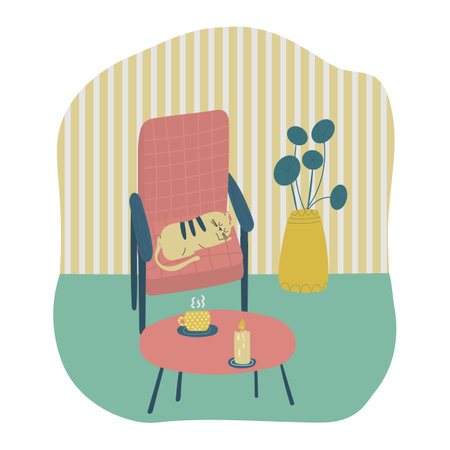Introduction: Blending Nordic and British Aesthetics
In the ever-evolving landscape of interior design, the marriage of Nordic minimalism with the inviting warmth of British cosiness is capturing the imagination of style enthusiasts across the UK. This unique narrative finds its heart in textiles and soft furnishings, where clean Scandinavian lines meet the plush, layered comfort that’s quintessentially British. As we explore this harmonious fusion, envision interiors where muted palettes and tactile simplicity from the North are softened and enlivened by rich textures, heritage fabrics, and subtle patterns reminiscent of classic British homes. This delicate balance not only enhances visual appeal but also creates spaces that feel both refreshingly modern and warmly familiar—a perfect reflection of contemporary living rooted in timeless traditions.
Choosing the Right Fabrics: Natural Textures and British Heritage
When curating textiles and soft furnishings to blend Nordic simplicity with British cosiness, the selection of fabrics becomes a crucial design decision. Emphasising natural fibres not only enhances tactile comfort but also echoes both Scandinavian minimalism and classic British tradition. From breezy linens to warm wools, each material brings its own story and character to your space.
Natural Fibres: A Foundation of Comfort
Linen, beloved in Scandinavian interiors for its understated elegance, creates a relaxed and effortlessly chic foundation. Its breathable quality is ideal for layering—drape linen throws across a sofa or choose linen-blend curtains to let the natural light filter softly into your room. Meanwhile, wool, a staple in both Nordic and British homes, offers warmth and texture. British wool, renowned worldwide for its durability and plushness, can be found in everything from chunky knitted cushions to statement rugs.
British Heritage Patterns: Tartan & Tweed
The story of British textiles would be incomplete without mentioning tartan and tweed. Rooted deeply in the UK’s cultural heritage, these patterns introduce subtle visual interest while maintaining a homely feel. Tartan blankets or tweed-upholstered armchairs evoke countryside manors and cosy Scottish cottages, perfectly complementing the clean lines of Nordic furniture.
Fabric Selection Guide
| Fabric Type | Nordic Influence | British Touch |
|---|---|---|
| Linen | Lightweight, airy texture; neutral tones | Natural undyed shades; rustic table runners |
| Wool | Soft throws; minimalist weaves | Tweed cushions; tartan blankets; Harris wool rugs |
| Cotton | Crisp white bedding; simple drapery | Brocade cushions; embroidered details |
Layering for Depth and Warmth
To master this style fusion, layer these fabrics thoughtfully throughout your home. Pair a linen-covered sofa with British wool tartan throws, or mix tweed scatter cushions with a pale cotton blanket. This approach not only balances the cool clarity of Scandinavian aesthetics but also infuses every room with the inviting warmth so cherished in British interiors.

3. Colours and Patterns: Muted Nordic Hues Meet British Boldness
When it comes to textiles and soft furnishings, the interplay between colour palettes and patterns is where the magic of merging Nordic simplicity with British cosiness truly shines. The Nordic approach favours understated elegance, featuring gentle greys, frosted whites, pale blues, and soft beige tones that evoke the serenity of Scandinavian landscapes. These muted hues create a calm foundation—perfect for layering different textures and letting natural light do its work in brightening interiors during long winters.
In contrast, British tradition leans into bolder choices. Think rich forest greens, deep navy blues, and classic burgundy reds—colours that have graced country cottages and stately homes for generations. Where the Nordics opt for minimalism, British style celebrates patterned fabrics: timeless florals inspired by heritage gardens, tartan checks reminiscent of Highland retreats, and houndstooth or herringbone weaves that nod to storied tailoring traditions.
The beauty lies in blending these two sensibilities. Start with a neutral Nordic backdrop—soft linen curtains or a woollen throw in dove grey—and introduce British flair through accent cushions adorned with William Morris-inspired prints or plaid upholstery on an armchair. Mixing subtle Scandinavian textures with characterful English motifs brings depth without visual clutter, creating spaces that feel both uncluttered and invitingly layered.
Don’t be afraid to experiment with scale: pair small-scale Nordic geometrics with large-scale British botanicals for a playful contrast. Or combine a subdued Scandi palette with one or two statement pieces in bold British colours—a mustard velvet footstool or a Liberty print lampshade—to add just enough vibrancy while maintaining harmony.
Ultimately, this thoughtful approach to colour and pattern allows you to curate interiors that are restful yet full of personality—a place where minimalist calm meets the warmth of homegrown tradition.
4. Layering Techniques: Achieving Depth and Comfort
Layering textiles and soft furnishings is an artful way to bring together the minimalist elegance of Nordic interiors with the enveloping warmth so cherished in British homes. This delicate balance can be achieved by thoughtfully combining throws, cushions, and rugs to create a space that feels inviting yet uncluttered. Below, we explore key strategies for layering that suit both Scandinavian simplicity and the classic British sense of cosiness.
The Foundation: Rugs as Anchors
Begin with a neutral or subtly patterned rug that grounds the room. In true Scandi style, opt for natural fibres such as wool or jute, but consider traditional British textures like thick-pile or tartan rugs for extra comfort underfoot. The key is to select a size that frames your seating area without overwhelming it, maintaining an open, airy feel.
Cushion Combinations: Mixing Textures and Tones
Cushions are essential for layering depth and softness. While Scandinavian design often employs a restrained colour palette—think soft greys, muted blues, and crisp whites—British cosiness favours richer tones such as deep greens, mustards, or burgundy. By blending these palettes, you can achieve harmony between understated elegance and homely warmth. Use a mix of textures like linen, velvet, and chunky knits to add tactile interest without visual clutter.
| Element | Scandi Approach | British Touch |
|---|---|---|
| Rugs | Natural fibres, light hues | Tartan patterns, plush pile |
| Cushions | Simple designs, minimal colours | Rich fabrics, layered patterns |
| Throws | Linen or cotton, cool tones | Wool or cashmere, warm shades |
The Art of Throw Placement
Drape throws with intention—over the arm of a sofa or at the foot of a reading chair—to invite relaxation while keeping surfaces neat. For a subtle nod to British tradition, fold throws neatly rather than leaving them tousled; this preserves the clean lines typical of Scandi interiors but adds a layer of comfort synonymous with British living rooms.
Achieving Balance: Less Is More
The secret to successful layering lies in restraint. Too many accessories can tip the scale from serene to chaotic. Instead, curate your selection: two to three cushions per seat and one throw per sofa or armchair usually suffice. This method ensures each item has purpose and presence, contributing both style and comfort without crowding your space.
By embracing these layering techniques—anchoring spaces with carefully chosen rugs, mixing cushions in complementary tones and textures, and thoughtfully placing throws—you can create interiors that blend Nordic simplicity with the plush embrace of British homes. The result is a home that feels effortlessly curated yet deeply comforting—a true reflection of both design heritages.
5. Accessorising the British Way: Personal Touches and Local Craft
Embracing British character in your home is all about celebrating individuality and heritage through carefully chosen accessories. Layering Nordic simplicity with quintessentially British accents can be achieved by introducing handmade textiles, vintage finds, and artisan soft furnishings that evoke a true sense of place.
Handmade Textiles: Celebrating Craftsmanship
Opt for handwoven throws in classic herringbone or tartan patterns, which nod to Britain’s rich weaving traditions. Locally produced cushions featuring embroidered details or woollen textures add both warmth and personality. These tactile elements not only soften the minimalist lines of Scandinavian design but also ground your space in a uniquely British context.
Vintage Finds: Stories Woven into Fabric
Scour local markets or antique shops for vintage blankets, lace-trimmed linens, and timeworn tapestries. Each piece carries its own story, infusing your home with nostalgia and character. Mixing these treasures with contemporary Nordic pieces creates a layered look that feels curated yet deeply personal.
Artisan Soft Furnishings: Supporting Local Makers
Seek out British artisans who craft bespoke lampshades, hand-stitched pouffes, or knitted ottomans using regional materials. These one-of-a-kind pieces bring authenticity and soul to your interiors while supporting local craftsmanship—a value deeply rooted in both British and Scandinavian design philosophies.
Ultimately, accessorising the British way means curating a home that feels lived-in and loved. By blending the understated elegance of Nordic style with the heartwarming touches of British craft, you create a space that is as inviting as it is beautiful—perfect for unwinding with a cup of tea on a rainy afternoon.
6. Sustainability and Timelessness
When curating textiles and soft furnishings that embody both Nordic simplicity and British cosiness, an awareness of sustainability and timeless design becomes essential. Thoughtful selection of materials—such as organic cotton, pure linen, or responsibly sourced wool—reflects a commitment to environmental responsibility deeply rooted in both Scandinavian and British values. These natural fibres not only offer tactile comfort and warmth but also age gracefully, acquiring character and softness over time.
Mindful Material Choices
Opting for sustainable textiles isn’t merely about ecological impact; it’s about creating interiors that feel authentic and enduring. Recycled fabrics, upcycled vintage finds, or locally crafted cushions are excellent ways to minimise waste while supporting local artisans—a sentiment cherished across the UK. These choices echo the Nordic ethos of longevity and function, blending seamlessly with Britain’s respect for heritage craft.
Timeless Patterns and Colour Palettes
To ensure your space never feels dated, focus on classic patterns—think subtle checks, understated stripes, or delicate botanicals—and muted, earthy tones. The fusion of Scandinavian neutrals with quintessentially British hues like moss green or slate blue creates a palette that feels both grounded and uplifting. Such combinations enhance a room’s character without overwhelming its serenity.
Investing in Longevity
Selecting fewer, higher-quality pieces—such as hand-stitched throws or heirloom quilts—encourages a ‘buy less, choose well’ mindset. This approach not only reduces clutter but also builds an interior narrative rich in personal meaning and visual harmony. By prioritising items that transcend fleeting trends, you invest in a home environment that grows more beautiful with each passing year.
In sum, layering Nordic simplicity with British cosiness through mindful textile choices ensures your space remains inviting, sustainable, and truly timeless—a sanctuary where quality and comfort are always in style.


